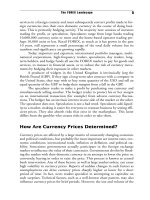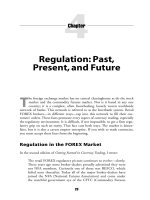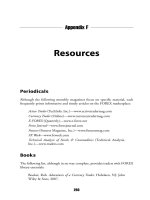Lecture Accounting: What the numbers mean (5/e) - Chapter 14: Cost analysis for planning
Bạn đang xem bản rút gọn của tài liệu. Xem và tải ngay bản đầy đủ của tài liệu tại đây (158.22 KB, 38 trang )
CHAPTER 14
COST ANALYSIS FOR
PLANNING
McGrawHill/Irwin
©The McGrawHill Companies, Inc., 2002
Learning Objectives
1. What is the cost terminology that
relates to the budgeting process?
2. Why are budgets useful, and how
does management philosophy
influence the budget process?
3. How are alternative budget time
frames used?
4. What is the significance of the sales
forecast (or revenue budget) to the
overall operating budget?
McGrawHill/Irwin
©The McGrawHill Companies, Inc., 2002
Learning Objectives
5. How is the purchases/production
budget developed?
6. What is the importance of cost
behavior patterns in developing the
operating expense budget?
7. Why are a budgeted income
statement and balance sheet
prepared?
8. How is the cash budget developed?
McGrawHill/Irwin
©The McGrawHill Companies, Inc., 2002
Learning Objectives
9. Why and how are standards useful in
the planning and control process?
10. How is the standard cost of a product
developed?
11. How are standard costs used in the
cost accounting system?
McGrawHill/Irwin
©The McGrawHill Companies, Inc., 2002
Learning Objective 1
• What is the cost terminology that
relates to the budgeting process?
McGrawHill/Irwin
©The McGrawHill Companies, Inc., 2002
Planning and Budgeting
• Planning is the initial part of the
planning and control cycle
• A budget is a plan in financial terms
• The results of an organization’s
activities will be reported in terms of
income, cash flow, and financial
position – the financial statements
McGrawHill/Irwin
©The McGrawHill Companies, Inc., 2002
Revisit Plans
Strategic,
Operational, and
Financial Planning
Planning and Control Cycle
Performance
Analysis:
Plans vs.
Actual Results
(Controlling)
McGrawHill/Irwin
Implement Plans
Data Collection and
Performance Feedback
Executing
Operational
Activities
(Managing)
©The McGrawHill Companies, Inc., 2002
Usefulness of Budgets
• The preparation of a budget forces
management to plan
• The budget provides a benchmark
against which to compare actual
performance
• The budgeting process requires
communication and coordination
among functional areas of a firm
McGrawHill/Irwin
©The McGrawHill Companies, Inc., 2002
Standard Costs
• A standard cost is a budget for each
component – materials, labor, and
overhead – of a product
• Standard costs are used in the planning
and control processes of manufacturing
and other types of companies
McGrawHill/Irwin
©The McGrawHill Companies, Inc., 2002
Cost Classifications
• Classifying costs based on the relationship of
total cost to volume of activity results in
categories of variable, fixed, and mixed costs
• Classifying costs according to a time-frame
perspective results in committed and
discretionary costs
– A committed cost is incurred to execute a long-range
policy decision
– A discretionary cost is one that can be adjusted in the
short term at management’s discretion
McGrawHill/Irwin
©The McGrawHill Companies, Inc., 2002
Learning Objective 2
• Why are budgets useful, and how
does management philosophy
influence the budget process?
McGrawHill/Irwin
©The McGrawHill Companies, Inc., 2002
The Budgeting Process in
General
• In a highly structured organization, the
budget is seen as carved in stone
• Management philosophy is reflected in
whether the budget is prepared using a topdown, dictated, approach or a participative,
managers involved, approach
• Most budgets are based on current budgets
with revisions
– the incremental approach
McGrawHill/Irwin
©The McGrawHill Companies, Inc., 2002
Learning Objective 3
• How are alternative budget time
frames used?
McGrawHill/Irwin
©The McGrawHill Companies, Inc., 2002
The Budget Time Frame
• Budgets can be prepared for a single period or
for several periods
• A single-period budget is prepared in the
months preceding the beginning of the year and
is used the entire year
• A multi-period or rolling budget involves
planning for segments of a year on a repetitive
basis
• The advantage of a continuous budget is that it
will be more accurate, but it takes more effort
McGrawHill/Irwin
©The McGrawHill Companies, Inc., 2002
The Budgeting Process
• First, develop and communicate assumptions
about the economy, the industry, and the
organization’s strategy
• The operating budget is made up of a number of
detailed budgets:
– Sales/revenue budget
– Purchases/production budget
– Operating expense budget
– Income statement budget
– Cash budget
– Balance sheet budget
McGrawHill/Irwin
©The McGrawHill Companies, Inc., 2002
Learning Objective 4
• What is the significance of the sales
forecast (or revenue budget) to the
overall operating budget?
McGrawHill/Irwin
©The McGrawHill Companies, Inc., 2002
Sales Forecast
• The sales forecast is the key to developing a
reasonable budget
• The most challenging component since there is so
little control over the variables that influence sales
• Need to consider the past experience of
managers, production capacity, pricing policy, and
advertising effectiveness
• The other budgeted items are a function of the
sales budget
McGrawHill/Irwin
©The McGrawHill Companies, Inc., 2002
Learning Objective 5
• How is the purchases/production
budget developed?
McGrawHill/Irwin
©The McGrawHill Companies, Inc., 2002
Purchases/Production Budget
• By using the cost of goods sold model with units,
the quantity of merchandise to be manufactured or
purchased can be determined – after the sales
budget
• The firm’s inventory policy determines the amounts
to be used in the computation
• The inventory policy should take into consideration
such factors as lead time and forecast errors
• The ending inventory for one period is the
beginning inventory for the next period
McGrawHill/Irwin
©The McGrawHill Companies, Inc., 2002
Budget Calculations as a Guide
• If a production budget calls for vastly
different quantities to be manufactured each
period, the production may be planned at a
constant level
• If materials can be purchased in certain
quantities, the purchase quantities nearest to
the calculated value will be used
• Budget calculations provide a guide to action
– not absolute amounts
McGrawHill/Irwin
©The McGrawHill Companies, Inc., 2002
Cost of Goods Sold Budget
• Once the sales budget and the
purchases/production budgets have been
prepared, the cost of goods sold budget can
be prepared
• Cost of goods sold consists of:
– Raw materials budget
– Direct labor budget
– Overhead budget
McGrawHill/Irwin
©The McGrawHill Companies, Inc., 2002
Learning Objective 6
• What is the importance of cost
behavior patterns in developing
the operating expense budget?
McGrawHill/Irwin
©The McGrawHill Companies, Inc., 2002
Operating Expense Budget
• Some operating expenses are variable
expenses:
– Sales commissions
• Some operating expenses are fixed:
– Depreciation
• Therefore, operating expenses are budgeted
according to their cost behavior patterns
• Budget slack occurs when managers larger
budgets than necessary
McGrawHill/Irwin
©The McGrawHill Companies, Inc., 2002
Learning Objective 7
• Why are a budgeted income
statement and balance sheet
prepared?
McGrawHill/Irwin
©The McGrawHill Companies, Inc., 2002
Budgeted Income Statement
• Use the sales forecast, the cost of
goods sold budget, and the operating
expense budget to prepare budgeted
income statement
• An important step in determining
profitability and overall satisfactory
results
McGrawHill/Irwin
©The McGrawHill Companies, Inc., 2002









